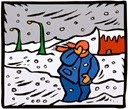Wind Chill
• Wind
chill is the temperature your body feels when the air temperature is combined
with the wind speed. It is based on the rate of heat loss from exposed skin
caused by the effects of wind and cold. As the speed of the wind increases, it
can carry heat away from your body much more quickly, causing skin temperature
to drop.
• Always be aware of what the wind temperature is before you or your children go outside. If you are unaware of the wind chill, it could be only a matter of time before frostbite and hypothermia set in.
• Always be aware of what the wind temperature is before you or your children go outside. If you are unaware of the wind chill, it could be only a matter of time before frostbite and hypothermia set in.
Frostbite
• Frostbite
is when the skin and outer tissues of the body have become frozen. This can
happen on fingers, toes, ears and nose. They may appear pale, gray and
blistered. Your child may complain that his/her skin burns or has become numb.
• Frostbite can happen quickly. The risk is increased in people with reduced blood circulation and among those not dressed properly for extremely cold temperature.
• The Centers for Disease Control and Prevention (CDC) say a victim is usually unaware of frostbite until someone else points it out because the frozen tissues are numb.
• If frostbite occurs, bring your child inside and place the frostbitten part in warm (not hot) water or apply warm washcloths to the area. Call your child’s health care provider if numbness continues for more than a few minutes.
• Frostbite can happen quickly. The risk is increased in people with reduced blood circulation and among those not dressed properly for extremely cold temperature.
• The Centers for Disease Control and Prevention (CDC) say a victim is usually unaware of frostbite until someone else points it out because the frozen tissues are numb.
• If frostbite occurs, bring your child inside and place the frostbitten part in warm (not hot) water or apply warm washcloths to the area. Call your child’s health care provider if numbness continues for more than a few minutes.
Hypothermia
• Hypothermia
is a medical emergency that occurs when your body loses heat faster than it can
produce heat, causing a dangerously low body temperature. This can happen when
your child is playing outside in extremely cold weather, if his clothing gets
wet or if he is not dressed appropriately for the weather.
• Hypothermia is most likely to occur at very cold temperatures, but it can occur even at cool temperatures (above 40 degrees Fahrenheit) if you become chilled from rain, sweat or submerged in cold water.
• Signs of hypothermia include shivering, becoming lethargic or clumsy and slurring speech. Infants will become bright red, have cold skin and very low energy.
• If you notice any of these signs in your child, contact his health care provider immediately or call 911. Take your child indoors, remove any wet clothing and wrap him in blankets or warm clothes until help arrives.
• Hypothermia is most likely to occur at very cold temperatures, but it can occur even at cool temperatures (above 40 degrees Fahrenheit) if you become chilled from rain, sweat or submerged in cold water.
• Signs of hypothermia include shivering, becoming lethargic or clumsy and slurring speech. Infants will become bright red, have cold skin and very low energy.
• If you notice any of these signs in your child, contact his health care provider immediately or call 911. Take your child indoors, remove any wet clothing and wrap him in blankets or warm clothes until help arrives.
With
a little knowledge and some advance preparation, you and your child will enjoy
the cold, winter season without any problems. Click here
for more information on how to stay warm and safe this winter.


No comments:
Post a Comment